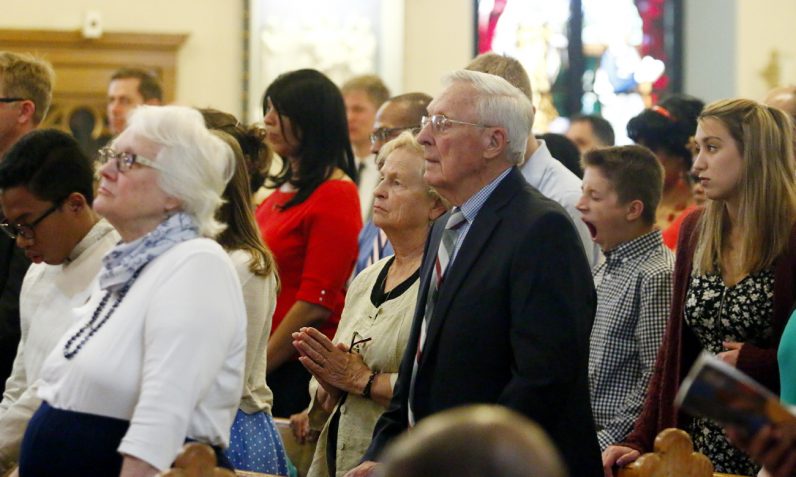WASHINGTON (CNS) — If “demography is destiny,” as was claimed in the 2016 presidential election, the United States could be facing some highly interesting political times ahead.
The American Values Atlas, released Sept. 6 by the Public Religion Research Institute, took note of the role religion plays in shaping trends in U.S. politics. The numbers may to some seem striking, but at the same time may provide confirmation of things long suspected.
One such piece of evidence: “The religious coalitions of the Democratic and Republican Parties are drifting further apart,” the study said.
[hotblock]
According to numbers gleaned from a Pew Research Center survey in 2006, 81 percent of Republicans identified as white Christian: white evangelical Protestant, 37 percent; white mainline Protestant, 22 percent; and white Catholic, 20 percent. At the same time, 47 percent of Democrats identified as white Christians: white evangelical Protestants at 17 percent, and white Catholics and mainline Protestants at 16 percent each.
The PRRI figures today show declines of Christian membership in both parties: down 8 percentage points to 73 percent for the GOP, but down 18 percentage points to 29 percent for the Democrats.
As for Catholics themselves, “the Catholic Church is experiencing an ethnic transformation,” the study said. In 1992, 87 percent of Catholics were white and non-Hispanic, compared to 55 percent today. And 36 percent of Catholics under age 30 are white, non-Hispanic; but 52 percent are Hispanic.
“The cultural center of the Catholic Church is shifting south,” the PRRI study added. “The Northeast is no longer the epicenter of American Catholicism — although at 41 percent Catholic, Rhode Island remains the most Catholic state in the country. Immigration from predominantly Catholic countries in Latin America means new Catholic populations are settling in the Southwest.”
Compared to 1972, when 69 percent of U.S. Catholics lived in either the Northeast or Midwest, those regions are home to only 46 percent of U.S. Catholics, with 54 percent living in the South or the West.
Dan Cox, the research director at PRRI, said political differences can be found within Catholics based on their ethnicity.
“There are still really significant racial and ethnic divisions. White Catholics are fairly different from Latino Catholics,” he told Catholic News Service in a Sept. 5 telephone interview.
“We see fairly insignificant differences where Catholics are on immigration. On some of the social issues, there is more of an alignment — abortion and same-sex marriage. On abortion, you see both groups little difference and a little more conservative on the legality of abortion. It’s really interesting because that’s where so much contention is nationally, but there’s more of an alignment between the white and the Latino Catholic factions. But on social welfare issues we see larger fractures within the Catholic population.”
White evangelical Protestants, the single largest religious subgroup in the PRRI study, make up 17 percent of Americans today, but are more than double that strength — 35 percent — in the GOP. In all, 73 percent of self-identified Republicans in the study said they were white Christians.
[hotblock2]
“What we’ve really seen over the last decade or more is that the Republican Party is becoming the white Christian party. That hasn’t changed” among Republicans, Cox told CNS. “Earlier, both (parties) were white Christian. “The ethnic and racial landscape has shifted. The Democratic Party has changed dramatically. The Republican Party has stayed the same, being predominantly white Christian.”
Yet in the space of a decade, the percentage of white evangelical Protestants fell from 23 percent to 17 percent. “White Catholics experienced a similar decline in membership, dropping five percentage points from 16 percent in 2006 to 11 percent in 2016,” the PRRI study said. White mainline Protestants also dipped five percentage points, from 18 percent to 13 percent.
“The Democratic coalition is also shedding white Christian members, who are fast becoming a minor constituency within the party,” the study said. “Among Democratic seniors, close to half identify as white Christian, including white evangelical Protestants (15 percent), white mainline Protestants (17 percent), or white Catholics (15 percent). Hispanic Catholics rival the number of white Christians,” it added. “A whopping 40 percent of young Democrats are religiously unaffiliated.”
One item in the study indicates that those who profess a Christian faith tend toward political conservatism.
“White evangelical Protestants and Mormons are the most conservative religious groups in the country,” the PRRI study said. “White mainline Protestants also lean more conservative than liberal (38 percent vs. 25 percent respectively), while white Catholics are about twice as likely to identify as conservative than liberal (42 percent vs. 22 percent, respectively).”
Translated into political affiliation, both white Catholics and white mainline Protestants go 34 percent Republican, 26 percent Democrat. While 31 percent of white Catholic seniors are Democrats, only 21 percent of white Catholic young adults identify as Democrats. And 56 percent of Hispanic Catholic seniors identify as Democratic, while only 35 percent of young Hispanic Catholics identify as the same.
The survey itself was based on 101,438 bilingual telephone interviews — 60,355 of those on cellphones — conducted between Jan. 6, 2016 and Jan. 10, 2017.
“Demography is incredibly important when we’re watching really substantial religious change in the U.S. — and over a relatively short period of time, given how glacial stuff like this happens,” PRRI’s Cox said.
The numbers, he cautioned, are “not necessarily completely reflective. If you look at voters, they tend not to be completely representative. Unaffiliated (Americans who don’t profess a religious faith) are about a quarter of the population but only 14-15 percent of all voters. The demography-is-destiny idea would only be true if 100 percent of all eligible voters voted. But because they don’t, we don’t see the impacts until several years in advance of these changes.”
PREVIOUS: Catholic officials applaud Illinois’ new scholarship tax credit program
NEXT: Parish life still thrives at flood-damaged Houston church




Share this story